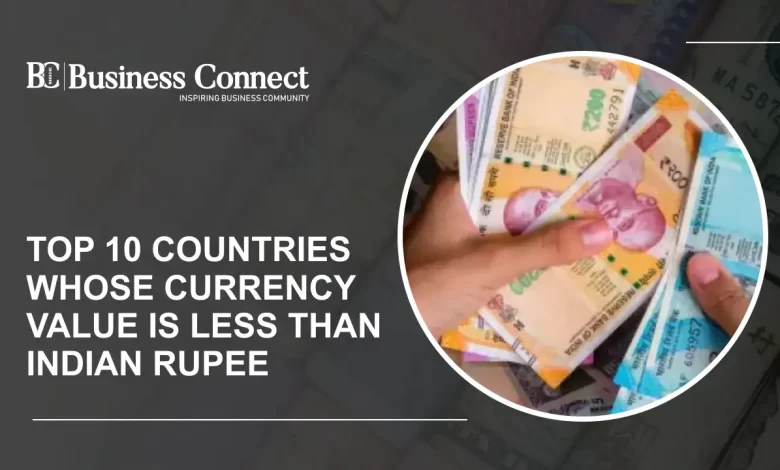Top 10 Countries Whose Currency Value Is Less Than Indian Rupee

Top 10 countries whose currency value is less than Indian rupee
In the most specific sense, currency is the money in any form which is used as a medium of exchange in different context such as finance, business, history and many more. It is issued by a government and accepted as a method of payment. In the 21st century, we have a new form of currency that is cryptocurrency or virtual currency such as Bitcoin which have no any physical form rather, they are traded and stored electronically.
Difference between money and currency
- Money is a broader term which refers to an intangible system of value which makes the exchange of goods and services. On the other hand, currency is one tangible form of money.
- Money can be stored of value overtime whereas currency loses its value overtime.
- The objective of money is to facilitate exchange whereas the objective of currency is to facilitate transaction.
Factors affecting lowering the value of currencies
There are various factors which can contribute to lower the value of currencies some of them are listed below-
- High inflation rates
- Lower interest rates
- Political instability and economic downturns
- Trade deficit where imports exceed exports
- High levels of national debt
- Monetary policies
- Geo political events
Top 10 countries whose currency value is less than Indian rupee
- Costa Rica (1 INR= 6.20 Colons)
It is a Central American country whose capital is San Jose. The sovereign state is a presidential Republic with us table constitutional democracy and educated workforce. Costa Rica borders the Caribbean seat to the east and Pacific Ocean to the West. Experiences of tropical climate year-round. there are 2 seasons. It is a country with the greatest biodiversity in the Latin America. The rainy season continues here from may to November and rice season is December to April. Corcovado National Park is internationally renowned among ecologists for its biodiversity and Isabel visitors can expect to see an abundance of wildlife. Many foreign companies operate in Costa Rica’s free trade zones where the benefit from investment and tax incentives. Over half of that type of investment has come from the US.
- Hungary (1 INR = 4.35 Forint)
It is a landlocked country in the central Europe whose capital is Budapest. The country borders Slovakia to the north, Romania to the east and southeast, Ukraine to the North East, Croatia and Slovenia to the South West, Austria to the West and Serbia to the South. It has 2 main waterways, the Danube and Tisza rivers. Hungry has a temperate seasonal climate with generally warm summers with low overall humidity levels but frequent range showers and cold snowy winters. It is a unitary parliamentary Republic. Hungry is an OECD high income mixed economy with a very high human development index and skilled labour force with the 16th lowest income inequality in the world. the economy is the 57th largest in the world with 265.037 billion dollars output.
- Nepal (1 INR = 1.60 Nepalese Rupee)
It is a landlocked country in South Asia which is mainly situated in the Himalayas but also includes parts of the indo Gangetic planes. The capital of this nation is Kathmandu. Nepal has a diverse geography including fertile planes, sab alpine forested hills and 8 of the world’s 10 tallest mountains including Mount Everest, the highest point on earth. Nepal Has a large diversity of animals and plants. As the eastern half of Nepal receives more rain compared to the western parts, it is rich in biodiversity. Nepal is a parliamentary Republic with multi-party system and has been referred as the federal Democratic Republic of Nepal since 2015. It is one of the least developed countries which ranks 165th in the world end nominal GDP per capita and 162nd in GDP per capita at PPP.
- Sri Lanka (1 INR= 3.51 Sri Lankan Rupee)
Sri Lanka is an island country in South Asia which lies in the Indian Ocean, South West of the Bay of Bengal, separated from the Indian peninsula by the gulf of mannar and the Palk Strait. The capital of the nation is Sri Jayewardenepura Kotte. It has 103 rivers. Sri Lanka claims an exclusive economic zone extending 200 nautical miles which is approximately 6.7 times Sri Lanka’s land area. The coastline an adjacent water support highly productive marine ecosystems such as fringing coral reefs and swallow bets of coastal and estuarine sea grasses. The climate is tropical and warm because of moderating effects of ocean wind. This country has the highest biodiversity per unit area among all the Asian countries in terms of all vertebrate groups except birds and flowering plants.
- Paraguay (1 INR= 93.14 Guarani)
It is a landlocked country in South America whose capital is Asuncion. It has a population of around 6.1 million nearly 2.3 million of home live in the capital is divided into 2 well differentiated geographic regions- Eastern and western regions. overall climate is tropical to subtropical. Wildlife in Paraguay include marsh deer, monkeys, bats, wild boars and many more. It is a representative Democratic Republic with a multi-party system add separation of powers across 3 branches.
- Cambodia (1 INR= 48.50 Riel)
It is a country and may launch South Asia whose capital is Phnom Penh. It shares it’s border with Thailand in the north west, Laos in the North East and Vietnam in the south east. The climate of Cambodia is dominated by monsoons which are known as tropical wet and dry. The biodiversity of Cambodia is largely founded on its seasonal tropical forests containing some recorded tree species and riparian ecosystems.
- Mongolia (1 INR = 40.43 Tugrik)
It is a landlocked country in East Asia bordered by Russia to the north China to the South. Ulaanbaatar is the capital of this country. It is the world’s largest landlocked country that doesn’t border closed see and much of its area is covered by grassy steppe with mountains to the north and West and the gobi desert to the South. it is known as the land of the eternal blue sky or country of sky because it has over 250 sunny days a year. Economic activity in Mongolia has long been based on herding and agriculture, although development of extensive mineral deposits of copper, coal, tin, tungsten and gold have emerged as a driver of industrial production.
- Zimbabwe (1 INR = 3.83 ZWD)
It is a landlocked country in South East Africa whose capital is Harare. Zimbabwe has a subtropical climate with many local variations. It contains 7 terrestrial eco regions. 300+ species of mammals can be found in Zimbabwe. There are also many snakes and lizards, over 500 bird’s species and 131 fish species. Zimbabwe is the Republic with a presidential system of government. The main foreign exports of this country are minerals, gold and agriculture.
- Vietnam (1 INR= 294.77 Dong)
Vietnam is a country at the eastern edge of mainland South East Asia whose capital city is Hanoi. It is located on the eastern indo Chinese peninsula. Vietnam is one of 25 countries considered to possess a unique high level of biodiversity. The country is ranked 16 in the entire globe in terms of biological diversity being home to approximately 16% of the total world species. Throughout the history of Vietnam, its economy has been based largely on agricultural sector primarily wet rice cultivation.
- Iceland (1 INR = 1.61 Icelandic Króna)
It is a Nordic island country between the North Atlantic and Arctic oceans, on the mid Atlantic rich between North America and Europe. Reykjavik is the capital city of this country. The climate of Iceland coast is subarctic. Islands economy dependent heavily on fishing with still provides nearly 20% of exports earning an employed 7% of the workforce.






